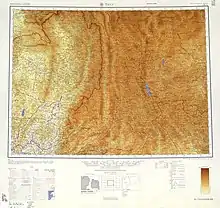Ta-li
See also: Appendix:Variations of "tali"
English

Map including TA-LI (T'AI-HO) (AMS, 1955)
Etymology
From Mandarin 大理 (Dàlǐ) Wade–Giles romanization: Ta⁴-li³.[1]
Proper noun
Ta-li
- Dated form of Dali.
- 1954, Herold J. Wiens, Han Chinese Expansion in South China, Shoe String Press, published 1967, →LCCN, →OCLC, pages 20–21:
- Viewing Yun-nan topographically from the large aspect, we may divide the province into three major regions: (1) Western Yun-nan including the great gorges west of Ta-li. The characteristic feature of this region is the parallel trends of rivers and mountain ranges. From altitudes of 16,000-19,000 feet in the north, the heights drop to 5000-5300 feet in the south;
- 1975, Milton Osborne, River Road to China The Mekong River Expedition, 1866-73, New York: Liveright, →ISBN, →LCCN, →OCLC, page 130:
- The situation changed from day to day, but at the moment the rebels occupied the important western city of Ta-li, set by a large lake and not far, the explorers believed, from the upper course of the Mekong.
Translations
Dali — see Dali
References
- Dali, Wade-Giles romanization Ta-li, in Encyclopædia Britannica
Further reading
- Leon E. Seltzer, editor (1952), “Tali”, in The Columbia Lippincott Gazetteer of the World, Morningside Heights, NY: Columbia University Press, →OCLC, page 1868, column 2
This article is issued from Wiktionary. The text is licensed under Creative Commons - Attribution - Sharealike. Additional terms may apply for the media files.